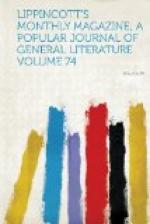[Illustration: KING’S CHAPEL, BOSTON, IN 1872.]
The American churches of the seventeenth and eighteenth centuries were plain structures, unpretending without and unadorned within; and this for other reasons than the poverty of the community, the lack of the best building-materials, and the absence both of architects and of artistic tastes. It was a simple ritual which most of them were to house, and the absence of an ornate service demanded the absence of ornamentation, which would be meaningless because it would symbolize nothing. The influence of the Puritans in Massachusetts, the Baptists in Rhode Island, the Dutch Reformed in New York, the Lutherans and Presbyterians in the Middle and Southern colonies, and the Friends in Pennsylvania, whatever their denominational differences, was a unit in favor of the utmost simplicity consistent with decency and order; and though there was a difference between Congregational churches like the Old South in Boston and the Friends’ meeting-houses in Philadelphia, the difference was far less marked than that existing between the new and old buildings of the Old South society, which the modern tourist may compare at his leisure in the Boston of to-day. Even the Episcopalians shared, or deferred to, the prevailing spirit of the time: they put no cross upon their Christ Church in Cambridge, nearly a hundred and thirty years after the settlement of the place, lest they should offend the tastes of their neighbors. The Methodists, the “Christians,” the Swedenborgians, the Unitarians and the Universalists were not yet, and the Moravians were a small and little-understood body in Eastern Pennsylvania.
[Illustration: KING’S CHAPEL BOSTON, IN 1872.]
Nearly all the colonists, of whatever name, brought from Europe a conscientious love of religious simplicity and unpretentiousness: for the most part, the English-speaking settlers were dissenters from the Church which owned all the splendid architectural monuments of the country whence they came; and it was not strange that out of their religious thought grew churches that symbolized the sturdy qualities of a faith which, right or wrong, had to endure exile and poverty and privation—privation not only from social wealth, but from the rich store of ecclesiastical traditions which had accumulated for centuries in cathedral choirs and abbey cloisters.




